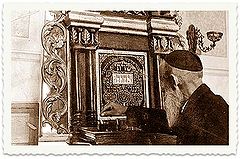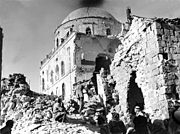| Revision as of 17:53, 27 December 2006 editChesdovi (talk | contribs)Autopatrolled, Extended confirmed users22,098 edits →Origins: added Image:Sefer Hamakneh.jpg← Previous edit | Revision as of 17:19, 28 December 2006 edit undoChesdovi (talk | contribs)Autopatrolled, Extended confirmed users22,098 edits added Image:Tiferes Yisrael Stamp.jpgNext edit → | ||
| Line 1: | Line 1: | ||
| ] | ] | ||
| The '''Tiferet Yisrael Synagogue''' was one of the most outstanding synagogues in the ] of ] which was destroyed by the Jordanians in the ] ]. Named after Rabbi ] of ], it was also known as the '''Nissan Bek Shul''' after its founder Rabbi Nissan Beck. | The '''Tiferet Yisrael Synagogue''' was one of the most outstanding synagogues in the ] of ] which was destroyed by the Jordanians in the ] ]. Named after Rabbi ] of ], it was also known as the '''Nissan Bek Shul''' after its founder Rabbi Nissan Beck. | ||
| ==Origins== | ==Origins== | ||
| ] | ] | ||
| Although ] had arrived in ] by ] it was only in ] that Rabbi Nissan Beck began plans for a Hassidic ]. Until then they had prayed in small, private locations like Rabbi ] house. | Although ] had arrived in ] by ] it was only in ] that Rabbi Nissan Beck began plans for a Hassidic ]. Until then they had prayed in small, private locations like Rabbi ] house. | ||
| Line 12: | Line 14: | ||
| ] | ] | ||
| Construction started in ]. Initially the ] authorities refused to grant permission to dig the foundations and when permission was eventually granted, the discovery of a ] grave at the site caused further problems. In time, the Muslim mayor agreed for the tomb to be moved outside the city walls. After the foundations had been dug, another setback cropped up. It became apparent that it was necessary to obtain a building permit from the officials in Turkey who were not keen to grant the request. Rabbi Beck, an Austrian national, convinced ] to intercede, and in ] a ] was granted. Over ten years were spent raising funds as the building slowly took shape. | Construction started in ]. Initially the ] authorities refused to grant permission to dig the foundations and when permission was eventually granted, the discovery of a ] grave at the site caused further problems. In time, the Muslim mayor agreed for the tomb to be moved outside the city walls. After the foundations had been dug, another setback cropped up. It became apparent that it was necessary to obtain a building permit from the officials in Turkey who were not keen to grant the request. Rabbi Beck, an Austrian national, convinced ] to intercede, and in ] a ] was granted. Over ten years were spent raising funds as the building slowly took shape. | ||
| ] | |||
| In November ] ] en-route to the inauguration of the ] made a visit to ]. Included in his itinerary was a tour of the ] institutions of the city. Franz Joseph, concerned with protecting the rights of his subjects living in the ], had helped secure the building permit necessary for the new synagogue. When he was shown the unfinished building without its dome, Rabbi Beck explained that due to the recent hardships of the ] of ] and ], he had been unable to solicit funds to complete the building. He added "but now, through the honour of the emperor’s visit to this holy site we hope the roof will be completed soon." Other reports of the conversation tell of how Rabbi Beck remarked to the emperor that “even the synagogue has removed its hat in your honour!” Consequently Franz Joseph, respected for his benevolent policy towards his Jewish subjects living in Jerusalem, donated 1,000 francs for the domes construction. | In November ] ] en-route to the inauguration of the ] made a visit to ]. Included in his itinerary was a tour of the ] institutions of the city. Franz Joseph, concerned with protecting the rights of his subjects living in the ], had helped secure the building permit necessary for the new synagogue. When he was shown the unfinished building without its dome, Rabbi Beck explained that due to the recent hardships of the ] of ] and ], he had been unable to solicit funds to complete the building. He added "but now, through the honour of the emperor’s visit to this holy site we hope the roof will be completed soon." Other reports of the conversation tell of how Rabbi Beck remarked to the emperor that “even the synagogue has removed its hat in your honour!” Consequently Franz Joseph, respected for his benevolent policy towards his Jewish subjects living in Jerusalem, donated 1,000 francs for the domes construction. | ||
Revision as of 17:19, 28 December 2006

The Tiferet Yisrael Synagogue was one of the most outstanding synagogues in the Old City of Jerusalem which was destroyed by the Jordanians in the 1948 Israel War of Independence. Named after Rabbi Israel Friedman of Ruzhin, it was also known as the Nissan Bek Shul after its founder Rabbi Nissan Beck.
Origins

Although Hassidim had arrived in Jerusalem by 1747 it was only in 1839 that Rabbi Nissan Beck began plans for a Hassidic synagogue. Until then they had prayed in small, private locations like Rabbi Israel Beck's house.
In the 1830's word reached Rabbi Israel Friedman of Ruzhin that Czar Nikolai I intended to build a church in the Jewish Quarter of the Old City of Jerusalem. Rabbi Friedman, who was very involved in assisting the yishuv, gave Rabbi Nissan Beck the task to thwart his attempts. Beck worked tirelessly to secure the plot of land the Russians had intended on buying and in 1843 with much effort and expense, succeeded. The Czar was forced to buy a different plot of land, known today as the Russian Compound, and in his frustration expelled Rabbi Friedman from Russia. When Rabbi Friedman died in 1851, his son Rabbi Abraham Jacob Friedman of Sadigura continued the task of raising the necessary funds for the project.
Construction

Construction started in 1857. Initially the Ottoman authorities refused to grant permission to dig the foundations and when permission was eventually granted, the discovery of a Muslim grave at the site caused further problems. In time, the Muslim mayor agreed for the tomb to be moved outside the city walls. After the foundations had been dug, another setback cropped up. It became apparent that it was necessary to obtain a building permit from the officials in Turkey who were not keen to grant the request. Rabbi Beck, an Austrian national, convinced Franz Joseph I of Austria to intercede, and in 1858 a firman was granted. Over ten years were spent raising funds as the building slowly took shape.

In November 1869 Franz Joseph I of Austria en-route to the inauguration of the Suez Canal made a visit to Jerusalem. Included in his itinerary was a tour of the Jewish institutions of the city. Franz Joseph, concerned with protecting the rights of his subjects living in the Holy Land, had helped secure the building permit necessary for the new synagogue. When he was shown the unfinished building without its dome, Rabbi Beck explained that due to the recent hardships of the Jews of Austria and Hungary, he had been unable to solicit funds to complete the building. He added "but now, through the honour of the emperor’s visit to this holy site we hope the roof will be completed soon." Other reports of the conversation tell of how Rabbi Beck remarked to the emperor that “even the synagogue has removed its hat in your honour!” Consequently Franz Joseph, respected for his benevolent policy towards his Jewish subjects living in Jerusalem, donated 1,000 francs for the domes construction.
The impressive three storey synagogue was completed in 1871 and inaugurated on August 19 1872, 29 years after the land had been purchased. For the next 75 years the Tiferet Yisrael synagogue served as the centre for the Hassidic community in the city.
 |
 |
 |
Destruction
During the Israel War of Independence, the Jordanian Legion captured the old city and the synagogue, which had served as a position for the defenders of the Jewish Quarter, was blown up one hour after midnight on the night of May 20-21 1948.
The first major Haganah stronghold to fall was the Nissan Bek Synagogue, the splendid building whose dome had been donated by the Emperor Franz Joseph. It was essential to Rusnack defence plan and the Haganah fought tenaciously to hold on to it…Fawzi el Kutub finally ordered eight of his men to rush across an open space and place a charge at the base of the synagogue. All of them were killed or wounded. No one would volunteer for a second try. Hoping to force his men’s hands by his example, Kutub sprinted across the space himself. When he got to the base of the synagogue, he saw that no one had followed him. Like a spider he pressed himself up against its wall until finally the Tunisian to whom he had promised a wife rushed out to him carrying a fifty-five pound charge. The explosion barely chipped the wall. Three more unsuccessful attempts were required before Kutub managed to blow a hole in the synagogue wall and a party of Legionnaires rushed through the smoke into Nissan Bek’s interior. Sure that the Haganah would counterattack and that the irregulars swarming into the synagogue would quickly turn to looting, Kutub decided to destroy it with a 220-pound charge. His strongest follower, a one-eyed former porter in the railroad station nicknamed the Whale, staggered up with the explosive. A terrible roar shook the quarter and blew out the heart of the building. As the smoke cleared and the frightful devastation caused by the bomb became apparent, Kutub heard a cry of consternation rising from the Jewish posts around him. It was quickly replaced by a triumphant yell. A small group of Haganah led by Judith Jaharan counterattacked and took the smoking ruins of Nissan Bek from the Arabs. As Kutub had suspected, the irregulars had spent their time looting the synagogue. The Haganah found the bodies of Arab irregulars killed in their counterattack with altar cloths around their waist, pages of the Torah stuffed into their shirts, pieces of chandeliers and lamps in their pockets.
 |
 |
 |
Following the Six Day War the decision was made to leave the ruins of the synagogue as they were. Only its western wall remains.
Mesivta Tiferet Israel of Ruzhin
In 1953 Rabbi Mordecai Solomon Friedman, the Boyaner Rebbe of New York, laid foundations for a new Hassidic centre in the new city of Jerusalem, and in the 1960's a new synagogue was built resembling the original design of the Tiferet Yisrael synagogue of the old city.
See also
References
- Collins, Larry (1973). "Ticket to a Promised Land". O Jerusalem. London: Pan Books. pp. 465–466. LCCN 97-0 ISBN 0-330-23514-1.
{{cite book}}: Unknown parameter|coauthors=ignored (|author=suggested) (help)